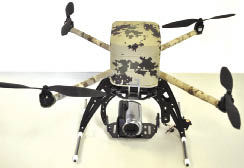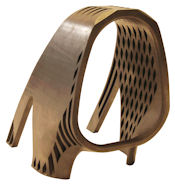Perfect Partners
Designing for manufacturability has already taken a back seat to optimized design in many industries, thanks to additive manufacturing.
Latest News
December 1, 2012
Additive manufacturing (AM) can optimize prototyping by allowing multiple physical iterations of a design to be quickly created and evaluated. However, the technology really shines when it’s used to create optimized end-use parts that would not be economically feasible to manufacture via traditional means. It’s a win-win situation when an optimal design can be realized with rapid manufacturing.
Jeff DeGrange, vice president of Direct Digital Manufacturing for Stratasys, has first-hand knowledge of end-use 3D printed parts. He worked at Boeing for more than 20 years, including a tenure leading the company’s advanced manufacturing efforts. He was the principal engineer involved in getting laser-sintered parts certified for use on F-18 fighter jets and later was the manager overseeing the use of AM on Boeing’s 787 Dreamliner.
“Even back in the late ‘80s and early ‘90s Boeing was using stereolithography,” he recalls. “We had one machine. I remember its serial number was 007. I called it the James Bond machine. It was used to make models for low-speed wind tunnels.”
Fast forward to today and end-use AM has spread well beyond aerospace. It’s especially found its niche in medical, jewelry, and specialty automotive industries, and it continues to spread into all corners of aerospace—from NASA rovers to unmanned aerial vehicles (UAV) to corporate jet interiors.
“There are a number of different things causing the growth of the technology in end-use parts,” says DeGrange. “Additive manufacturing now has a broader array of materials, the machines are getting bigger and faster, and the price points are coming down on those machines.”
Design Optimization Meets Rapid Manufacturing
We may be able to add optimization strategies to that list of growth factors. The use of optimization software could help engineers realize AM is the perfect partner for building optimized design concepts for lighter weight products that meet strength requirements while using less materials.
| F1 Roll Hoop Design
|
“With additive manufacturing, imagine an I-beam that is not all solid—it could be made out of trusses. It doesn’t necessarily need to be solid,” DeGrange says. “It could be a lattice structure that bridges the beam to distribute the weight of the load. That would use less material and energy to manufacture, if it could be manufactured—and it can with direct digital manufacturing.”
AM can enable manufacturability without compromise in many situations, what DeGrange calls “low-volume, high-product mix” environments.
One such environment is the racing industry, which creates many of its customized parts. For example, Joe Gibbs Racing (JGR) recently used Stratasys’ Fortus system to manufacture a filter housing that is mounted in line with the driver’s air conditioning to help clean the air blown into the driver’s helmet.
“The complex design of the part makes it ideal for an FDM (Fused Deposition Modeling) application,” said Brian Levy, a JGR design engineer, in a case study published by Stratasys. “If we tried to machine the part, we would be forced to sacrifice some of its performance to satisfy machining constraints.”
Faster Time to Market
 Leptron’s RDASS 4 remotely powered helicopter.
Leptron’s RDASS 4 remotely powered helicopter.In addition to greater flexibility when it comes to manufacturability, designs intended for AM can also help optimize the manufacturing process by saving time and money.We can see one example of this in Leptron’s use of AM to develop components for its 5-lb. remotely powered helicopter, the RDASS 4. Design variations are needed for the specialized applications of the company’s different customers.
According to the company, injection molding would have cost $250,000 and taken six months to build tooling for the RDASS 4’s fuselage components. Design changes would have required more time and expense to modify the tooling. Using Stratasys’ Dimension 3D printer, the RDASS core components can be printed in 48 hours, and smaller components are printed in 6 hours. According to the company, it cost $100,000 to 3D print the parts needed for prototypes and eight production UAVs.
“We made approximately 200 design changes during the course of the project,” said John Oakley, chief executive officer of Leptron, in a case study published by Stratasys. “It would not have been possible for a company of our size to design and build this product using conventional manufacturing methods.”
Material Challenges
While many AM materials—from Stratasys’ FDM and Objet’s PolyJet materials, to sintering materials from EOS, Arcam, and others—are used in manufacturing, it’s only the tip of the iceberg. DeGrange says one factor is still holding back more mainstream adoption: a lack of understanding of AM material properties.
“We need to teach this, and not just at select universities, to explain that additive manufacturing is not just for prototyping,” he says. “It really needs to start in the education system.”
Beyond academia, Stratasys is compiling material test reports that come from accredited third-party sources to show how the company’s materials stand up vs. heat, cold, gasoline, flames, etc.
Both Arcam and Stratasys are also working with Oak Ridge National Laboratory to advance AM materials’ acceptance by manufacturers, and to develop new materials.
“One goal is a thermal plastic that has the same strength as aluminum,” DeGrange says. “You could do complex shapes and parts for automobiles to minimize weight for improved fuel efficiency. You could optimize parts with complex geometries to enhance crash worthiness by putting materials where they’re needed to channel forces away from drivers and passengers.”
To meet mainstream adoption goals, the industry needs a broader array of materials and material pricing needs to drop, DeGrange says. But with the industry and government working to meet those challenges, realizing the full promise of optimized design using AM doesn’t seem out of reach.
Jamie Gooch is the managing editor of Desktop Engineering. Contact him at [email protected].
INFO
Subscribe to our FREE magazine, FREE email newsletters or both!
Latest News
About the Author
Jamie Gooch is the former editorial director of Digital Engineering.
Follow DE






 An F1 racecar’s rear roll hoop is a structure that protects the driver’s head in the cockpit, serves as air intake for the car, plus includes camera mounts and pick-up points.The heavy component at such a high point on the car is not ideal. 3T RPD’s goal was to get the weight of this component down to 1 kilo (2.2 lbs.), which would drop 1 to 2 kilos. Because of the weight constraints of F1 cars, ballast is commonly used to balance the car and meet minimum weight. By reducing the weight of the roll hoop, engineers can put the saved weight lower down in the car design, thereby improving the overall performance of the vehicle.3T RPD teamed up with Within Technologies to create a new design for the roll hoop. Using Within Enhance software, which has an optimization process linked to an internal finite element analysis (FEA) process, the team created a lightweight design, which incorporated thin walls and internal features. They were also able to minimize the number of support structures that usually accompany metal AM processes. —Susan Smith
An F1 racecar’s rear roll hoop is a structure that protects the driver’s head in the cockpit, serves as air intake for the car, plus includes camera mounts and pick-up points.The heavy component at such a high point on the car is not ideal. 3T RPD’s goal was to get the weight of this component down to 1 kilo (2.2 lbs.), which would drop 1 to 2 kilos. Because of the weight constraints of F1 cars, ballast is commonly used to balance the car and meet minimum weight. By reducing the weight of the roll hoop, engineers can put the saved weight lower down in the car design, thereby improving the overall performance of the vehicle.3T RPD teamed up with Within Technologies to create a new design for the roll hoop. Using Within Enhance software, which has an optimization process linked to an internal finite element analysis (FEA) process, the team created a lightweight design, which incorporated thin walls and internal features. They were also able to minimize the number of support structures that usually accompany metal AM processes. —Susan Smith